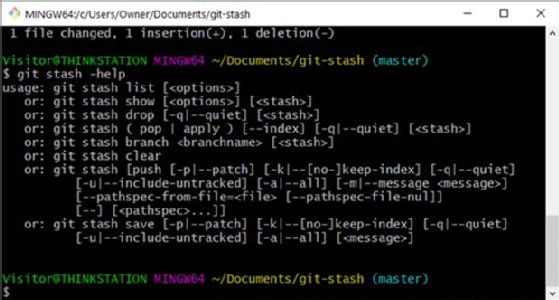


Saved working directory and index state On branch1: modified README.md $ git stash save "my_stash_name"īack to the example we gave before on the branch named “branch1”, we would run $ git stash save "modified README.md" In order to create a git stash with a name, use the “save” command and specify the name of your stash. In this case, no names were assigned to our stash which might not be very handy if you want to pop your stash later on. Saved working directory and index state WIP on branch1: 808b598 Initial commitĪs you can see, my working directory as well as my index was saved for the “branch1” which is the current name of my branch.Īfter the colons, you can see the hash of the HEAD commit as well as the commit message : this is the name of your stash. $ git stashĪs a consequence, all the changes staged for commit in your current working directory will be saved on the side for later use. It allows you to save changes that you might need at a later stage and is the fastest way to get your working directory clean while keeping changes intact.The easiest way to create a git stash is to simply run the “git stash” command without any parameters. It's handy when you need to switch between contexts. git directory /.git/refs/stash, to be precise) and allows you to retrieve the changes when you need them. Git stash stores the changes you made to the working directory locally (inside your project's. Run git stash pop to get your stashed changes back.Commit and (optionally) push to remote.Here's the sequence to follow when using git stash: A stash is locally scoped and is not pushed to the remote by git push. You can then reapply the stashed changes when you need them. Git stash saves the uncommitted changes locally, allowing you to make changes, switch branches, and perform other Git operations. This is exactly the kind of scenario git stash is designed for.
#Git stash command Patch#
The first method, although appearing conventional, is less flexible because the unfinished saved changes are treated as a checkpoint rather than a patch that's still a work in progress.

Git immediately aborts the operation and throws the error, "Your local changes to the following files would be overwritten by checkout … Please commit your changes or stash them before you switch branches." You quickly save your changes to A and try to check out branch B with git checkout B. While working on some files in branch A, your team asks you to fix a bug in branch B.

The A and B branches have diverged from each other for quite some time and have different heads. Suppose you are working on a repository with two branches, A and B. Assume for a moment that Git doesn't have a command to stash changes. The first thing to understand is why stashing changes in Git is important.


 0 kommentar(er)
0 kommentar(er)
